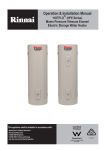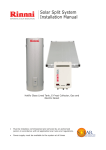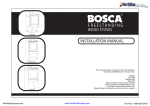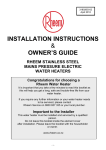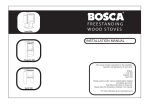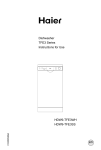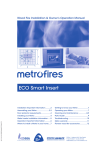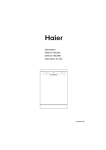Download Rinnai HOTFLO Installation manual
Transcript
Hotflo Solar Enabled Electric Storage Water Heater Operation and installation manual Must be installed, commissioned and serviced by an authorised person in accordance with all applicable local rules and regulations. If the Hotflo Electric Storage Water Heater is being used for a solar installation, please refer to separate operating and installation instructions. The Rinnai Hotflo Electric Storage Water Heater is not suitable for use as a pool or spa heater. Owner, please retain this manual for future reference. Limited Warranty Rinnai warranty summary table Tank All other parts (thermostats, elements etc.) Domestic Application Commercial Application Parts 5 years 3 years Labour 3 years 1 year Parts 1 year 1 year Labour 1 year 1 year All terms of the warranty are effective from the date of installation of the Rinnai Hotflo Electric Storage Water Heater. Proof of installation date will be required. Domestic vs. commercial application The reason for distinguishing between a domestic and commercial application is because the expected life of a system is directly related to the hours of use. A domestic application is defined as an installation that serves a single residential dwelling which is not used for commercial purposes, such as a hair salon, catering kitchen, motel or communal care facility. All other installations are defined as a commercial application. General warranty terms Rinnai reserves the right to make modifications and change specifications and its parts without notice. For the purposes of the Consumer Guarantees Act 1993, Rinnai only guarantees the availability of repair facilities and spare parts for the express warranty periods recorded in the Rinnai Warranty Summary Table. If the Hotflo Electric Storage Water Heater is being acquired for personal, domestic or household use, this warranty does not limit any consumer rights or guarantees that may apply under the Consumer Guarantees Act 1993. If the product is being acquired for the purposes of a business, the provisions of the Consumer Guarantees Act 1993 do not apply and no other warranties (either express or implied by law) apart from those stated in this warranty apply. Limited Warranty Warranty terms and conditions 1. All terms of this warranty are effective from the date of installation. The attending service person reserves the right to verify this date. 2. All Rinnai appliances must be installed, commissioned, serviced, repaired and removed in accordance with the manufacturer’s installation instructions, local regulations, and municipal building codes by persons authorised by local regulations to do so. 3. All appliances must be operated and maintained in accordance with manufacturer’s operating instructions. 4. The warranty applies only to the components supplied by Rinnai. It does not apply to components supplied by others, such as, isolating valves, electrical switches, pipe work, electrical cables, fuses, and where applicable components supplied by others, but not limited to these. 5. Where the appliance has not been sited in accordance with the installation instructions or installed such that normal service access is difficult, a service charge will apply. If at the discretion of the attending service person the installation is deemed illegal or access is dangerous, service will be refused. Any work required to gain reasonable access to the appliance will be chargeable by the attending service person (for example, removal of cupboards, doors, walls, or the use of special equipment to move components, but not limited to these). 6. Where a failed component is replaced under warranty, the balance of the original appliance warranty will remain effective. The replacement part or appliance does not carry a new warranty. 7. Rinnai reserve the right to transfer functional components from defective appliances if they are suitable. 8. Rinnai reserve the right to have the installed product returned to the factory for inspection. 9. Where the water heater is installed outside the metropolitan area or further than 40 km from a Rinnai authorised service centre, travel costs shall be the owner’s responsibility. Limited Warranty Warranty exclusions The following exclusions may cause the warranty to become void and will result in a service charge and costs of parts (if required). 1. Accidental damage and acts of God. 2. Failure due to abuse or misuse, improper maintenance or improper storage. 3. Failure due to incorrect or unauthorised installations. 4. Failure or damage caused by alterations, service or repair work carried out by persons other than Rinnai service persons or service centres. 5. Where the water heater has failed directly or indirectly as a result of poor water quality outside the limits specified. 6. Where it is found that there is no fault with the appliance and the issue is related to the installation or is due to the failure of electric or gas supplies. 7. Subject to any statutory provisions to the contrary, Rinnai does not accept: a. liability for consequential damage or any incidental expenses resulting from any breach of the warranty, b. claims for damage to building or any other consequential loss either directly or indirectly due to leaks from the solar collector or any other faults. Water Quality Water quality outside the limits (as set down below) will void this warranty. Water quality tests must be carried out at the customer’s own cost but Rinnai will reimburse any reasonable test costs where water quality is within the limits tabled. Water Quality and Impurity Limits TDS (Total Dissolved Solids) Total Hardness CaCO3 Dissolved (free) CO2 pH Langelier Index Up to 600 mg/L or ppm Up to 200 mg/L or ppm Up to 25 mg/L or ppm 6.5-8.5 Between -1.0-0.8 Most metropolitan water supplies fall within these limits. If you are unsure about water quality, please contact Rinnai and we will provide you with the details of an authorised agency able to test your water for compliance to Rinnai standards. If sludge or foreign matter is present in the water supply, a suitable filter should be incorporated in the water supply. Some examples of water quality issues where water may need to be treated: • • • Hard water (areas including Wanganui) Aggressive water (areas including Christchurch) Both hard and aggressive water (some bore water) Proof of purchase Please keep these instructions in a safe place for future reference. RECORD AND ATTACH YOUR PROOF OF PURCHASE BELOW: Your Retailer:__________________________________________________ Name:_______________________________________________________ Address:______________________________________________________ _____________________________________________________________ Telephone:( _______ ) __________________________________________ Date of Purchase: ______ / ______ / _________ Contents Introduction 7 For your safety 8 Maintenance 9 Troubleshooting 10 Installation: Dimensions and suitability 11 Installation: Plumbing setup 12 Installation: Connections and settings 13 Installation: General information 14 Installation: Valves and fittings 17 Installation: Plumbing connections 18 Installation: Commissioning 19 WARNING Improper installation, adjustment, alteration, service or maintenance can cause property damage, personal injury or loss of life. For assistance or additional information contact Rinnai on 0800 RINNAI (0800 746 624). Introduction Rinnai is committed to providing quality heating solutions. The Rinnai Hotflo Electric Storage Water Heater range offers innovation, quality and energy efficiency. This manual has been developed to: • • • Help you understand how your Hotflo Electric Storage Water Heater operates Identify what you need to do to maintain your Hotflo Electric Storage Water Heater Assist in troubleshooting in the unlikely event that a problem should occur Some facts about your storage water heater How it works A vitreous enamel lined steel tank stores water. This water is heated by an electric element located at the base of the cylinder. The temperature of the water is controlled by an automatic thermostat that is preset to 65 °C to disinfect water for Legionella. Safety devices For safe operation your electric storage tank is fitted with a: • Temperature Pressure and Relief (TPR) Valve that ensures the water remains at a safe pressure and temperature • Automatic thermostat to maintain water temperature • Temperature override cutout for the heating element DANGER: The operation of the thermal cutout indicates a possibly dangerous situation. Do not reset the thermal cutout until the water heater has been serviced by a qualified person. It is important that you do not tamper with or remove these devices. In the case of the TPR valve, do not block or seal either the valve or drain pipe. Anode Your electric storage cylinder is fitted with a sacrificial anode designed to extend the life of the tank. It will slowly dissipate protecting the cylinder and should be changed every five years (more frequently in hard/aggressive water areas). Space should be left above the cylinder to allow anode replacement. If the tank is being used in a solar installation Please refer to the Solar Operation and Installation Manuals as there are different operating and installation requirements. Rinnai New Zealand Limited Hotflo Electric Storage Water Heater Operation and Installation: 11151-C 03-10 For your safety General Your system must be installed, commissioned and serviced by an authorised person in accordance with all applicable statutory regulations. Do not remove element cover, this will expose 230 V wiring and must only be removed an authorised person. If any component is damaged, it must be replaced by an authorised person using replacement parts from Rinnai. Children should be supervised to ensure they do not play with the appliance. This appliance is not intended for use by persons (including children) with reduced physical, sensory or mental capabilities, or lack of experience and knowledge, unless they have been given supervision or instruction concerning use of the appliance by a person responsible for their safety. Care should be taken not to touch the pipe work connecting to the storage cylinder as this will be very hot. Scald hazard Hot water can cause scalds, Children, disabled and the elderly are at the highest risk of being scalded. Always feel the water temperature before showering or bathing. Scalds from hot water taps can result in severe injuries. Scalds can occur when children are exposed directly to hot water when they are placed in a bath that is too hot. Hydrogen gas If the hot water is not used for two weeks or more, a quantity of hydrogen gas which is highly flammable, may accumulate in the storage tank. To dissipate this safely, it is recommended a hot tap (non electrical) be turned on for two minutes at a sink, basin or bath. During this procedure there must be no smoking, open flame or any other appliance operating nearby. If hydrogen is discharged through the tap, it will make a sound like air escaping. Safety devices Your system is supplied with various safety devices including temperature sensors, overheat sensors/switches and a Temperature & Pressure Relief (TPR) valve. DO NOT: ▪ ▪ ▪ Tamper with or remove safety devices Block or seal the TPR valve and drain pipe Operate the system unless all safety devices are fitted and are in working order Protection against legionella Your system has been preset with specific temperature settings to disinfect water for legionella. Do not adjust these unless instructed by an authorised person. Rinnai New Zealand Limited Hotflo Electric Storage Water Heater Operation and Installation: 11151-C 03-10 Maintenance Your Rinnai Hotflo Electric Storage Tank requires little maintenance, but for maximum performance the following is recommended. Every six months: Every five years: TPR valve—operate easing gear Check and service entire system and replace TPR valve and anode if required Temperature & Pressure Relief Valve (TPR) This valve is located near the top of the tank and is essential for safe operation. Every six months operate the easing gear to remove lime deposits and to verify that it is not blocked. As this will discharge hot water, ensure no one is near the drain line. DANGER: Failure to operate the relief valve easing gear at least once every six months may result in the water heater exploding. Continuous leakage of water from the valve may indicate a problem with the water heater. It is very important that you raise and lower the easing gear gently. During this operation, if the valve does not discharge water when the easing gear is lifted, or does not seal again when closed, attendance by an authorised person must be arranged immediately. water heater lift until water flows from drain line, lower gently drain line During servicing of your tank the TPR valve needs to be checked and or replaced. This needs to be done by an authorised person at intervals not exceeding five years, or more frequently in areas where the water is classified as hard. A TPR valve must not be replaced with one that has a higher pressure rating than that specified for your cylinder. Anodes in glass lined tanks Storage tanks manufactured from metal can be susceptible to corrosion. The combined effects of water pressure, temperature and water chemistry can create an aggressive environment for corrosion of some materials. For this reason anodes are placed in glass lined tanks so as to corrode first and should be changed every five years (more frequently in hard/aggressive water areas). Draining and filling the system Normally only occurs during installation or servicing and must be carried out by an authorised person. Turning the water heater off and on If you plan to be away for only a few nights, we suggest you leave the system switched on. If it is necessary to switch off the tank, the switch is usually marked and located in the electricity box of the dwelling. When switching back on remember that the tank will take time to heat back up again. This will be dependent on the size of tank you have purchased. Rinnai New Zealand Limited Hotflo Electric Storage Water Heater Operation and Installation: 11151-C 03-10 Troubleshooting Lack of hot water or no hot water Is there electricity supply to the water heater? Check that the isolating switch marked ‘Hot Water’ or ‘Water Heater’ at the meter box is switched on. Check also any isolating switches installed near the water heater are switched on. Check the fuse or circuit breaker marked ‘Hot Water’ or ‘Water Heater’ at the meter box. Repeated failure of fuse or tripping of circuit breaker indicates a fault which must be investigated by an authorised trades person. Most water heaters are controlled at peak times by your electricity supplier via a ripple relay. Contact your electricity supplier to determine if there have been issues with power supply. Are you using more hot water than you think? Often you don’t realise how much water is actually being used. This applies especially when showering. Typical flow rates for showers is around 8-10 litres per minute. Conduct a simple experiment by placing a measured bucket under your shower for 10 seconds and multiply by 6 to obtain the amount of water produced over a minute. If your result is significantly more than the rates above you may want to consider installing a low flow shower rose available at all good plumbing outlets. Cold Water Relief Valve discharging continuously? It is normal for the Cold Water Relief Valve to discharge a small quantity of water through the drain line. If water is discharging continuously there may be a fault with one of the valves, contact your installer to discuss. High electricity bills If you think your electricity bill is too high, investigate the following: • • • • There may have been change to your electricity tariff since your last bill Cold Water Relief Valve is discharging continuously, refer above You may be using more hot water than you think, refer above for further details There may be hot water pipe/tap leakages, have these checked by your local plumber Servicing and repair If any electrical component of the system is damaged, it must be replaced by an authorised person. These components must be a genuine replacement part available from Rinnai. If the system needs servicing or should a problem occur, please call 0800 RINNAI (0800 746 624) from a land line and selection option one for a service centre in your area. Service calls relating to any condition or fault not related to the Rinnai Hotflo Electric Storage Water Heater and its components may be charged. Do not attempt to carry out any service work other than that mentioned in the troubleshooting pages. Rinnai New Zealand Limited 10 Hotflo Electric Storage Water Heater Operation and Installation: 11151-C 03-10 Installation: Dimensions and suitability B C OUTLETS P&TR D A INLETS E F Rinnai model name Model number A B Hotflo 135 L C D HFE12545 1245 590 515 1020 Hotflo 180 L HFE16045 1530 590 515 Hotflo 215 L HFE20045 1825 590 515 Hotflo 270 L HFE25045 1265 760 Hotflo 340 L HFE31545 1510 760 E F Weight kg (empty) 225 155 62 1310 225 155 71 1605 225 155 98 685 985 260 155 87 685 1200 260 155 101 all dimensions are in mm Suitability for use • Mains and low pressure systems • Domestic and commercial water heating applications • Domestic and commercial solar water heating applications • Indoor or outdoor installations • Left or right hand plumbing connections Hard or aggressive water will need to be treated in order to use this product, please test before use. Rinnai New Zealand Limited 11 Hotflo Electric Storage Water Heater Operation and Installation: 11151-C 03-10 Installation: Plumbing setup Hot O utlet TPR Drain A Ho lter t O nat ut e le t g perin Tem e C ° 5 5 Va l v ouse 5°C H 5 t o ly H Supp ssure y l Pre ld Suppl a u q E se Co Ho u Cylinder Drain Pressure Reducing Valve ECV Drain Filter Stop Cock E CV A Co lter ld nat In e le t Catch Pan drain Catch Pan Cylinders should be installed to AS/NZS3500.4, with reference to G12/AS1 where appropriate. The Rinnai Hotflo Electric Storage Water Heaters are suitable for mounting either inside or outside. For servicing and maintenance, please allow sufficient room for access to covers, valves and anodes. Rinnai New Zealand Limited 12 Hotflo Electric Storage Water Heater Operation and Installation: 11151-C 03-10 Installation: Connections and settings Pressure Limiting Valve Rinnai Hotflo Electric 135, 180 and 215 L Rinnai Hotflo 270 and 340 L = 700 kPa (approx.) = 500 kPa (approx.) If the water supply pressure exceeds the rated pressure, a pressure limiting valve is to be fitted to the installation. Cold Water Pressure Relief Valve Rinnai Hotflo Electric 135, 180 and 215 L Rinnai Hotflo 270 and 340 L = 850 kPa (approx.) = 700 kPa (approx.) Temperature & Pressure Relief Valve (TPR) Rinnai Hotflo Electric 135, 180 and 215 L Rinnai Hotflo 270 and 340 L = 1000 kPa = 850 kPa The TPR valve is supplied with the cylinder. Water may drip from the discharge pipe of the pressure relief device, the pipe must be left open to the atmosphere. The discharge pipe is to be installed in a continuous downward direction and in a frost-free environment. Drain valve Provision must be made to drain the cylinder if required for servicing. Drain lines These must be installed in accordance with AS3500 and/or G12/AS1. G12 is available online at no cost from: www.dbh.govt.nz/building-code-compliance-documents. Thermostat setting (maximum) 75 °C Hot and cold water connections ¾ ” (20 mm) Ingress protection rating IPX4 Rinnai New Zealand Limited 13 Hotflo Electric Storage Water Heater Operation and Installation: 11151-C 03-10 Installation: General information Location Base requirements Cylinders should be installed on a flat level base of sufficient strength to support the weight of the water heater when full. The water heater must also be suitably restrained against seismic activity, ‘G12/AS1 Figure 14’ details an acceptable method of restraint. Access to cylinder Cylinders should not be located where they will be difficult to remove, such as in attic spaces or built into cupboards or shelves. Where a cylinder is not easily accessible for maintenance and replacement, the Rinnai Warranty will not cover any additional costs caused by access difficulty. This is important for glass lined tanks where access is required to change the anode at the top of the cylinder. Catch pan It is important a suitably drained catch pan is fitted where damage could be caused by discharge from the cylinder. The Rinnai Warranty does not cover any consequential loss from leaks to the cylinder. Water quality The water quality of most public supplies is suitable for the water heater. Water quality from bore wells is generally unsuitable. Refer to the water quality parameters in the warranty section at the front of this manual for further information. If the water heater is supplied by low pressure gravity or tank water supply, the bottom of the supply must be at least one meter above the highest hot water outlet. Care must be taken to avoid air locks. Pipe sizing and valve selection must be performed to allow for the water supply pressure. Hot water storage and delivery temperatures Storage temperature Local regulation states that hot water shall be stored at a minimum temperature of 60 °C. The thermostat setting on the storage water heater has been factory preset to 65 °C to meet this requirement. The thermostat temperature setting is adjustable to a maximum temperature setting of 75 °C but this is usually not required. ▪ Thermostat settings must only be adjusted by an electrician or other suitably qualified trades person ▪ The access cover to the element and thermostat must only be removed by an Electrician or other suitably qualified trades person. Rinnai New Zealand Limited 14 Hotflo Electric Storage Water Heater Operation and Installation: 11151-C 03-10 Installation: General information Hot water storage and delivery temperatures Sanitary fixtures delivery temperature Water temperatures over 55 °C can cause severe scalds. Local regulations must be considered regarding temperature limitations of hot water supplied to areas used primarily for personal hygiene. The temperature is limited to 45 °C for early childhood centres, schools, nursing homes or similar facilities and 55 °C for all other buildings. To comply with these requirements, a temperature limiting device, such as a tempering or thermostatic mixing valve will be required on all installations. Water pipes All hot water pipe work should be insulated with Polythene foam or equivalent insulation to optimise performance and energy efficiency. Water pipe sizing should be performed in accordance with AS/NZS 3500.4 and/or G12 AS1. To prevent damage to the water heater when attaching pipe clips or saddles to the jacket, it is recommended that self drilling screws with a maximum length of 12 mm are used. If drilling is required take extreme care not to penetrate the inner cylinder. Damage to the inner cylinder is not covered by warranty. Connection to a supplementary heat source When the water heater is connected to a supplementary heat source, such as a solar system, heat pump or wetback, the system must be arranged so that the water does not exceed 80 °C to prevent damage to the cylinder lining, operation of the TPR valve or the thermostat thermal cutout. For a split solar system this can achieved by turning off the circulating pump once the water being drawn from the cylinder exceeds 65 °C. Electrical supply and connections Electrical connection must be carried out by a qualified person and in accordance with NZ Electrical Regulations. The water heater must have the heating element connected to an independent, fused, AC 230 V 50 Hz power supply with an isolating switch installed at the switch board. WARNING ▪ ▪ ▪ The water heater must be filled with water prior to connection to the power supply Disconnect all power prior to installation and commissioning Household wiring to the heater must be capable of withstanding the appliance load Rinnai New Zealand Limited 15 Hotflo Electric Storage Water Heater Operation and Installation: 11151-C 03-10 Installation: General information Electrical supply and connections Electrical access is via a 20 mm hole beneath the element cover for mounting with an approved weatherproof electrical conduit nipple. For entry to the element cover remove the two fixing screws. Connect all ACTIVE and NEUTRAL wires in accordance with the wiring diagram. Ensure the incoming EARTH wire is securely fixed to the earth post provided on the heater case. Inspect and ensure all wiring links are secure prior to fixing the access cover and turning the power on. To ensure the over-temperature and energy cutout is set press the ‘reset’ button on the thermostat. Single Element Wiring Diagram Thermostat setting The thermostat is adjustable from 60 °C to 75 °C. Turning the adjustment knob anticlockwise decreases the temperature setting and turning it clockwise increases the temperature setting. Rinnai advise that the thermostat is factory set at 65 °C. This temperature is sufficient for most users. The access cover to the element and thermostat must only be removed by an electrician or other suitably qualified trades person. The thermostat setting must only be adjusted by an electrician or other suitably qualified tradesperson. Rinnai New Zealand Limited 16 Hotflo Electric Storage Water Heater Operation and Installation: 11151-C 03-10 Installation: Valves and fittings Valves with pressure ratings other than those listed in this manual must not be used. Valves and fittings supplied with the water heater Valves and fittings supplied with the water heater are placed in the Styrofoam packaging during transit. The pressure ratings of the valves are shown on the ‘Connections and settings’ page. The following valves and fittings are supplied: ▪ A combined Temperature and Pressure Relief Valve (TPR), this is a safety device and mandatory that it is fitted to the top of the cylinder by the installer in all installations ▪ Two brass plugs to plug the unused hot and cold connections ▪ Four ¾ MF Adaptors to assist with fitting plumbing connections ▪ A reducing bush to enable fitting the ¾” TPR Valve connection to the ½” tank connection Installer to supply The following valves and fittings are to be supplied by the installer: ▪ A cold water Expansion Control Valve (ECV) must be fitted ▪ Pressure limiting valve ▪ A stop cock and non return valve, these are fitted to the cold water supply to the water heater, (combination valves incorporating these functions are suitable) ▪ A temperature limiting device such as a tempering valve, if required Refer to the ‘Connections and settings’ page for the pressure settings for the ECV and Pressure Limiting Valve Rinnai New Zealand Limited 17 Hotflo Electric Storage Water Heater Operation and Installation: 11151-C 03-10 Installation: Plumbing connections Refer to the diagram in the ‘Plumbing location’ page for the location and specification of each plumbing connection to the water heater. The water heater has dual handed cold water supply and hot outlet connections. The brass plugs supplied are used to plug unused connections. TPR valve connection The TPR Valve must be fitted before the water heater is operated. Before installation ensure that the probe is straight and undamaged. 1. Seal the thread with Teflon tape, never use hemp. Make certain the edge of the Teflon tape does not protrude past the end of the thread. 2. Screw the reducing bush supplied into the fitting on the water heater marked TPR Valve, then screw the valve into the reducing bush. Leave the outlet pointing down. 3. Tighten the valve using the spanner flats, never use the valve body. Expansion control valve The ECV must always be installed after the non return valve and be the last valve installed before the water heater. Drain lines Provision must be made to drain the cylinder before servicing. Copper drain lines (½” or DN15) must be fitted to the TPR Valve and ECV. The length should be as short as possible on a continuous downward slope with no restrictions. Length should not exceed 9 m with no more than three right angle bends. In areas where pipes are prone to freezing drain lines must be insulated. The drain line must be provided with an air gap to ensure the line drains completely. The outlet of drain lines must be positioned over a suitable gully trap so that they are readily visible and the discharge will not cause injury, damage or nuisance. Rinnai New Zealand Limited 18 Hotflo Electric Storage Water Heater Operation and Installation: 11151-C 03-10 Commissioning Commissioning and draining activities must be carried out by an authorised person. To fill and turn on the water heater 1. Open all hot water taps in the house including the shower. 2. Open the cold water isolation valve to the water heater. Air will now be forced out of the taps. 3. Close each tap when water runs freely without air bubbles. 4. Check all plumbing connections and pipe work for water leaks. 5. Switch on the electric power supply. To turn off the water heater It may be necessary to turn off a water heater after installation and commissioning, for example during building activities or if the premises are vacant. 1. Switch off the electricity supply at the isolating switch to the water heater. 2. Close the cold water isolation valve at the inlet to the water heater. To drain the water heater 1. Turn off the water heater as above. 2. Close all the hot water taps. 3. Gently operate the TPR Valve release, this will relieve the pressure in the water heater. 4. Open the drain valve having ensured no damage will occur from discharged water. 5. Operate the TPR Valve again. This allows air into the water heater and will result in water draining. Exporter Warning Statement • The water heater is not intended to be operated or adjusted by young children or infirm persons. Young children must be supervised to ensure they do not interfere with the water heater. • Temperature Pressure Relief Valve is to be operated regularly to remove lime deposits and ensure the valve is not blocked. • The water heater must be installed in accordance with local electricity regulations such that the water heater is isolated and will disconnect in high voltage situations. • A pressure relief device should be installed in a frost free environment, in the right position and with a discharge line in a continuous downwards direction. Rinnai New Zealand Limited 19 Hotflo Electric Storage Water Heater Operation and Installation: 11151-C 03-10 Consumers: Installers: 0800 RINNAI (746 624) 0800 TO RINNAI (86 746 624) Address: 105 Pavilion Drive, Airport Oaks, Mangere, Manukau PO Box 53177, Auckland Airport, Manukau 2150 Phone: Fax: (09) 257 3800 (09) 257 3899 Email: Website: [email protected] www.rinnai.co.nz All Rinnai appliances meet or exceed the safety standards required by New Zealand gas and electrical regulations. Rinnai is constantly improving its products and as such information and specifications are subject to change or variation without notice.




















